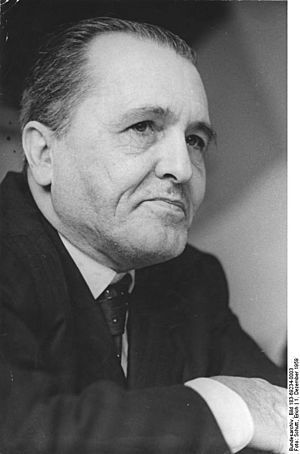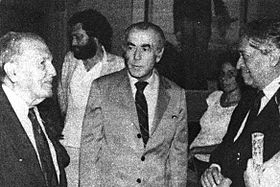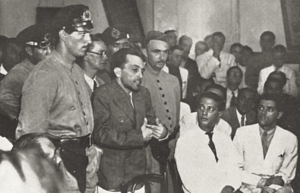Luís Carlos Prestes facts for kids
Quick facts for kids
Luís Carlos Prestes
|
|
|---|---|

Luis Carlos Prestes in 1959.
|
|
| Senator for the Federal District | |
| In office February 1, 1946 – January 9, 1948 |
|
| General Secretary of the Brazilian Communist Party | |
| In office 28 August 1943 – 12 May 1980 |
|
| Preceded by | Antonio Maciel Bonfim |
| Succeeded by | Giocondo Dias |
| Personal details | |
| Born |
Luís Carlos Prestes
January 3, 1898 Porto Alegre, Rio Grande do Sul, Brazil |
| Died | March 7, 1990 (aged 92) Rio de Janeiro, Rio de Janeiro, Brazil |
| Political party | PCB (1934–84) |
| Spouses |
Olga Benário
(m. 1934; died 1942)Altamira Sobral
(m. 1950) |
| Children | 8, (including Anita) |
| Alma mater | Military School of Realengo |
| Profession | Military engineer |
| Signature | |
| Nickname | The Knight of Hope |
| Military service | |
| Allegiance |
|
| Years of service | 1919–1936 |
| Rank | Captain |
| Unit | Prestes Column |
| Battles/wars |
|
| Awards |
|
Luís Carlos Prestes (born January 3, 1898 – died March 7, 1990) was an important Brazilian revolutionary and politician. He was the main leader of the Brazilian Communist Party from 1943 to 1980. He also served as a senator for the Federal District from 1946 to 1948.
Prestes was known as "The Knight of Hope" because of his leadership in the 1924 tenente revolt. This was a movement of young army officers who wanted to change the government. After this revolt, he led a group of rebel soldiers, called the Prestes Column. They marched for three years across Brazil, trying to get farmers to oppose the government. Even though this effort failed, he became a hero to many people.
Later, he became the general-secretary of the Brazilian Communist Party. This party wanted to stop paying the country's debts, take control of foreign-owned companies, and change land ownership. He was put in prison after a big uprising in 1935. He was released after World War II and briefly served as a senator. He was a strong voice against the government during the Vargas Era in Brazil.
In the 1980s, Prestes felt the Brazilian Communist Party was moving away from its original ideas. He was removed from his leadership role in 1980 and left the party in 1984. He supported another politician, Leonel Brizola, in the 1989 presidential election.
Contents
Early Life and the Tenente Revolt
Luís Carlos Prestes was born in Porto Alegre, in the state of Rio Grande do Sul, on January 3, 1898. His father was an army officer. When his father left the family, they faced money problems. Prestes joined the Military School of Realengo in Rio de Janeiro when he was 21. He finished his training in 1919, specializing in military engineering, and was the top student in his class.
Prestes helped plan the revolt of 1922. However, he missed the actual "March of the 18" because he was sick with typhoid fever. Since he wasn't directly involved, he avoided prison and was instead moved to Rio Grande do Sul.
The 1924 revolt started to try and end the First Republic. Prestes became a key leader in the Tenentes movement. This movement was named after the "tenentes," or lower-ranking officers, who played a big part in the revolts of 1922 and 1924. Prestes became famous when he led a combined group of tenentes and rebels. This group became known as the "Prestes Column."
Over almost three years, the column marched about 25,000 kilometers (16,000 miles) across thirteen Brazilian states. The column protested the politics of the First Republic (1889–1930). They weren't strong enough to overthrow the government directly. But they were strong enough to avoid being caught by government forces. The column eventually went into exile in Bolivia in 1927. His ability to avoid defeat made Prestes a folk hero in Brazil and around the world.
Life in Exile (1927–1930)

While in Bolivia, Prestes worked on building roads and other projects. In late 1927, the leader of the Brazilian Communist Party (PCB), Astrojildo Pereira, visited Prestes in Bolivia. Pereira gave Prestes some books about Marxism and suggested he join the Communist Party.
At first, Prestes said no to Pereira's idea. He stayed in Bolivia until late 1928, then moved to Argentina and found work as an engineer. It was during this time that Prestes finally read Marxist books. He began to agree with socialism. His talks with important communist figures also helped him understand these ideas.
The 1930 Revolution
The tenente revolts helped bring an end to the old "coffee and milk" politics in Brazil. The Brazilian Revolution of 1930 ended Brazil's Old Republic. Many moderate tenentes joined this revolution, but Prestes did not. The Revolution of 1930 put Getúlio Vargas in power as Brazil's temporary president.
The tenentes wanted Prestes to join Vargas. So, Prestes met Vargas in Porto Alegre and explained his ideas for a socialist revolution. Vargas was very impressed by Prestes. He even gave money to the revolutionary cause.
However, Prestes saw Vargas as leading a revolution for the wealthy class. He believed Vargas would just replace one unfair system with another. So, Prestes decided not to join Vargas. He tried to create his own movement, but it didn't get enough support. Prestes continued to use Marxist ideas to understand Brazilian politics. But he was left out of the Brazilian Communist Party, which was changing its structure. Eventually, Prestes went into exile again, this time in Uruguay.
Joining the Communist Movement
In 1931, Prestes went to the USSR. There, he worked as an engineer and continued to study communism. In late 1934, he returned to Brazil. He was with Olga Benário, who would soon become his wife. She was an agent sent to protect him.
In 1935, Prestes became a member of the Communist International's executive committee. He was said to have gained the trust of Stalin. In the same year, he became the leader of the National Liberation Alliance (ANL). This was a group of socialists, communists, and other progressives. They were led by the Communist Party and opposed Vargas's actions against workers' unions.
Getúlio Vargas, who was now Brazil's official president, wanted to rule with more power. He tried to stop his enemies on the left, led by Prestes, using violence. Vargas had joined forces with powerful landowners and the Integralists, a fascist movement. Vargas's power forced the Brazilian Congress to react to the growing communist movement.
While some of Prestes's former friends moved to the right politically, Prestes became unhappy with Vargas's government. As Prestes joined the ANL, its members grew in 1935. The ANL then released a statement calling for Vargas's government to be overthrown. Vargas used this as an excuse to declare the ANL illegal. When Prestes and other ANL members started an uprising in November 1935, Vargas's government quickly stopped it. Prestes avoided the first arrests, but by March 1936, both he and Olga were imprisoned. Because Olga was a foreigner, Vargas sent her, while pregnant, back to Nazi Germany.
After the revolt failed, the leaders were arrested and put on trial in 1937. Prestes was sentenced to 16 years in prison. In 1943, while still in prison, Prestes was chosen as the general secretary of the Communist Party of Brazil.
Imprisonment and Persecution
Because Vargas had more political power, the Brazilian Congress called all leftist opposition "subversive" under a new law in March 1935. This law allowed the President to ban the ANL. With these new emergency powers, the government cracked down on the left. There were arrests, torture, and quick trials. By mid-1935, Brazilian politics became very unstable. In July, the government moved against the ANL, raiding offices and jailing leaders. The ANL tried an armed uprising in November, but it was quickly defeated. The government, like fascist governments in Europe, responded by imprisoning Prestes and violently crushing the communist movement.
Vargas, trying to gain support from Brazil's fascist movement, allowed a wave of anti-Jewish feeling. He may have targeted Prestes's wife to please his new supporters. Vargas sent Luís Carlos Prestes's pregnant, German-Jewish wife, Olga Benario, to Nazi Germany. She later died there.
Political Career
After Vargas started to move away from his authoritarian rule in 1945, political prisoners were released. Prestes was freed from prison in May 1945 as part of an amnesty.
When the Vargas government was overthrown in October 1945, new elections were held. Prestes understood Vargas's changing politics, saying, "Getúlio is very flexible. When it was popular to be a fascist, he was a fascist. Now that it is popular to be democratic, he will be a democrat." Even after how Vargas treated him and his wife, Prestes supported Vargas for the sake of national unity.
Prestes quickly returned to politics. With about six months before the presidential election, Prestes began to reorganize the Communist Party. It only had about 4,000 members. The communists showed surprising strength in the elections, getting about 700,000 votes, or 15 percent of the total.
In the elections of December 2, 1945, Prestes received the most votes in his race for senator of the Federal District. However, Prestes's election happened at the start of the Cold War.
As a senator, Prestes helped write a new constitution in 1946. Later that month, Vargas was removed from power by a conservative part of the military. This happened partly because Vargas was making more liberal changes. The communist movement was then persecuted again. In May 1947, the Brazilian government made the Communist Party illegal. Congress then removed its communist members. Prestes immediately went into hiding and worked secretly for 10 years.
Prestes supported Juscelino Kubitschek in the 1955 election. He began to play a more public role even though the Communist Party was still illegal. When João Goulart became president in August 1961, Prestes and others on the left saw a chance for real changes for Brazil's workers and farmers. He publicly pushed Goulart to speed up reforms. However, during the Cold War, many people, including the middle classes, conservatives, and the military, feared communism. To prevent a communist "dictatorship," the military overthrew Goulart and started a conservative dictatorship.
Once again living under a right-wing government, Prestes went into hiding and then exile. The military targeted other Communist Party members. Even while his former friend Eduardo Gomes served as a minister in the military government, Luís Carlos Prestes was always trying to avoid military repression. Prestes was a long-time leader in Brazilian communism. But the different ideas within Marxism, both globally and in Brazil, changed his role in the 1960s.
The experiences of the failed tenente rebellion and Vargas's crackdown on the communist movement made Prestes and some of his friends doubt armed conflict for the rest of his life. This doubt later caused a split in the Brazilian Communist Party in the early 1960s. Prestes led the group that supported the Soviet Union, known as the Brazilian Communist Party (PCB). The other group, called the Communist Party of Brazil (PCdoB), followed Maoist ideas. While the Maoists went underground and fought against the military dictatorship after 1964, Prestes's group did not.
Later Life and Death
In 1970, Prestes went to Moscow with his second wife, Maria Prestes, and their children. He only returned to Brazil 10 years later, after an amnesty was given to political prisoners. By the mid-1970s, the dictatorship had largely stopped other armed leftist groups. It then focused on the PCB, targeting and killing some of its top leaders. But by that time, Prestes had been in exile for several years.
Prestes finally returned to Brazil with the military's general amnesty of 1979. This pardon released political prisoners and exiles. It also pardoned military members involved in torture or killings. Even with Prestes back, the Communist Party was still divided. They argued about whether to support the country's return to democracy or to demand a more radical revolution. Many people recognized Prestes's historical importance. But they felt that, at over 80 years old, he was no longer the right leader. He was removed from his position as secretary-general of the PCB.

He became a supporter of the Brazil's Democratic Labour Party. He took part in Leonel Brizola's presidential campaign in 1989.
In his final days, Prestes had very little money. He was mostly supported by architect Oscar Niemeyer, who was a long-time communist supporter. Prestes died of a heart attack on March 7, 1990, at the age of 92.
See also
 In Spanish: Luís Carlos Prestes para niños
In Spanish: Luís Carlos Prestes para niños
- Olga Benário Prestes
- Carlos Marighella
- João Goulart
- Getúlio Vargas
- Brazilian Communist Party
- Tenentism
- Brazilian communist uprising of 1935
- The Knight of Hope, a book about Prestes by Jorge Amado
- Coluna Prestes, a march that may have inspired the Chinese Long March





